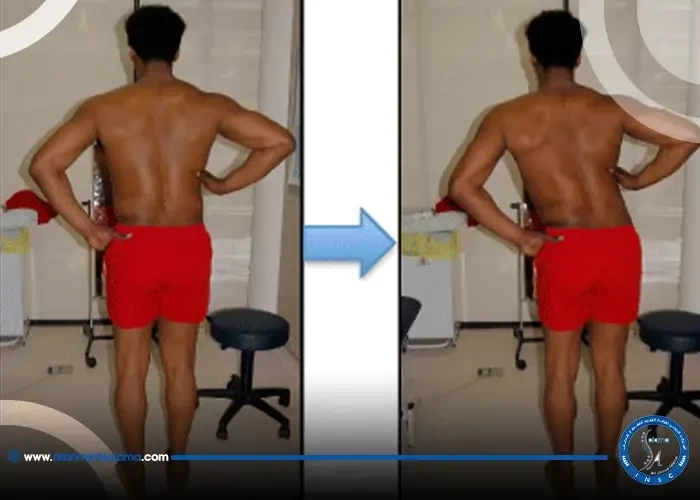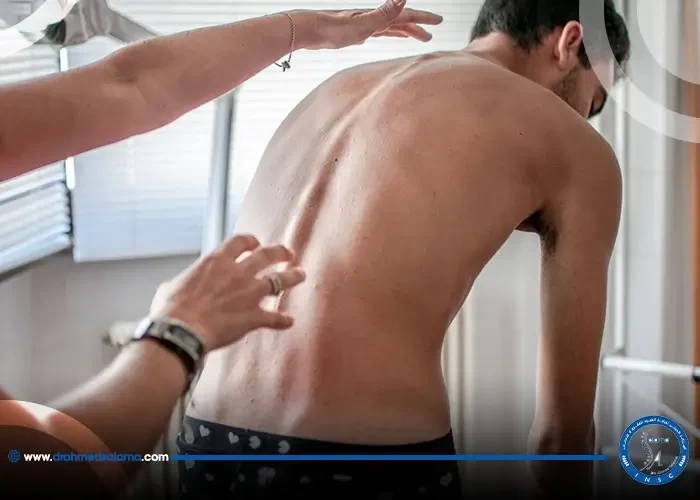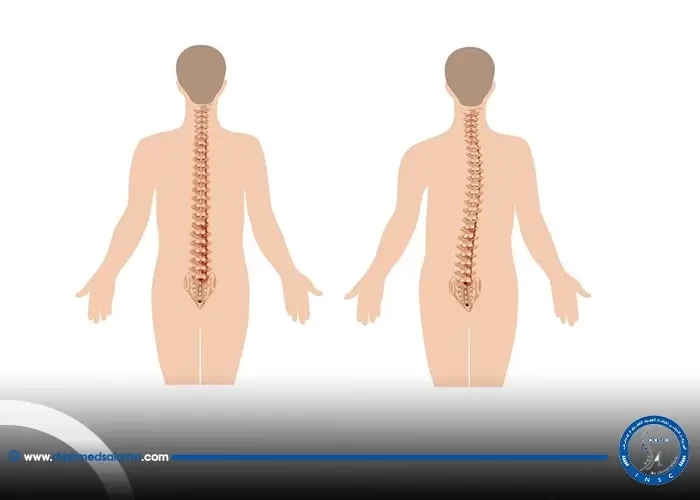Nasr City, 52 El Tayaran Street, in front of the Health Insurance Hospital

Neck cartilage formation

The shape of a cervical disc arouses the curiosity of many who suffer from pain or problems in the cervical spine, which can significantly impact their quality of daily life. This prompts them to wonder: When is a cervical disc dangerous? And can a cervical disc be cured?
In this article, we will learn about the shape of a herniated cervical disc in detail, the symptoms and treatment of a cervical disc, the side effects of disc surgery on the fourth and fifth cervical vertebrae, and offer advice for cervical disc patients to help them deal with the condition consciously and effectively. All this is done with Dr. Ahmed Ibrahim Salama, a consultant neurosurgeon and spine surgeon, one of the best specialists in treating cervical disc problems in Egypt.
The Shape of a Cervical Disc
A cervical disc is a flexible disc located between the vertebrae of the spine. It contains a fluid-rich, gelatinous nucleus surrounded by a tough, fibrous outer layer. Its function is to absorb shocks and provide flexibility and stability to the spine. Although some use the term "cervical disc" to refer to any problem in this area, this term is not medically accurate. The disc itself is a normal part of the anatomical structure of the spine. The real problem lies in damage, wear, or a herniation that can affect this disc with age or excessive stress, compressing the surrounding nerves, causing pain, numbness, or impaired movement. In the next section, we will learn about what a herniated disc in the neck looks like.
What a herniated disc looks like in the neck
A herniated disc in the neck occurs when the gelatinous material inside the intervertebral disc between the cervical vertebrae shifts from its normal position, compressing the nerves or spinal cord. A herniated disc in the neck usually appears as a protrusion or bulge of the disc, which can be mild or severe, and is clearly visible on a CT scan or MRI as a mass pressing on the nerves. This change in the shape of the disc in the neck is what causes common symptoms such as neck pain, numbness, and muscle weakness in the shoulders or arms.
To obtain an accurate diagnosis and a deeper understanding of the nature of a herniated cervical disc and the best treatment options, we recommend you book a consultation with Dr. Ahmed Ibrahim Salama, a consultant neurosurgeon and spine surgeon, to ensure you receive specialized medical care using the latest treatment methods.
When is a cervical disc dangerous?
A cervical disc is not dangerous in and of itself, as it is part of the normal structure of the cervical spine. However, the danger lies when the normal shape of the cervical disc becomes herniated, leading to a herniated disc in the cervical spine. This can put pressure on the nerves or spinal cord. If this condition is left untreated, serious symptoms may develop, such as muscle weakness, numbness, and loss of sensation in the extremities, difficulty walking or loss of balance, and sometimes problems controlling urine or stool. These are signs that require immediate medical attention to avoid more serious complications.
To manage this condition before it worsens, it is important to consult a specialist with experience in diagnosing and treating cervical disc problems, such as Dr. Ahmed Ibrahim Salama, to ensure you receive an accurate and safe treatment plan tailored to your condition.
Symptoms and Treatment of Neck Disc Herniation
The symptoms and treatment of neck disc herniation vary depending on the extent of the change in the shape of the disc and the level of pressure it causes on the nerves or spinal cord. The condition may develop gradually, initially causing mild discomfort, then progress to chronic pain or more severe neurological symptoms, making early diagnosis and treatment essential. These symptoms include:
Weakness or slackness in the neck muscles.
Numbness or tingling in the shoulders.
Pain and stiffness in the neck.
Recurring headaches.
Persistent pain in the shoulder area, sometimes extending to the arms and fingers.
Increased pain when sitting, standing, sneezing, or tilting the head back.
Numbness or loss of sensation in the neck, arms, or upper body.
Muscle stiffness that impairs movement.
Sharp, electric-shock-like pain below the shoulder blades that may radiate to the arms.
Because neglecting these symptoms can lead to permanent complications, it is recommended to consult Dr. Ahmed Ibrahim Salama for a comprehensive evaluation of your condition and appropriate treatment using the latest medical techniques.
Neck Disc Treatment
Treatment methods for neck discs vary depending on the severity of the symptoms and the extent to which the disc has deviated from its normal shape. Treatment aims to reduce pressure on the nerves, relieve pain, and restore neck movement. The most prominent treatment methods for neck discs include:
Conservative Treatment
In mild cases, the doctor recommends some conservative methods that help control symptoms and improve neck movement, such as:
Applying cold or hot compresses to the painful area.
Maintaining proper neck posture while sitting or sleeping.
Avoid sudden bending or strenuous activities.
Practicing light exercises to strengthen the neck and back muscles.
Medication Treatment
The doctor prescribes some medications to relieve pain and reduce inflammation, including:
Analgesics and nonsteroidal anti-inflammatory drugs.
Muscle relaxants.
Medications specifically designed to relieve nerve pain.
Vitamins such as vitamin B12 to support nerve health.
Physical Therapy
The doctor may recommend physical therapy sessions for some cases to improve muscle flexibility and reduce pressure on the nerves. These include:
Exercises to improve blood circulation and relieve pressure on the nerves.
Ultrasound therapy.
Electrical muscle stimulation.
Heat or cold therapy.
Injection Therapy
Steroid injections are an effective option for treating cervical disc herniation without surgery. The medication is injected directly into the herniated disc to reduce inflammation and swelling around the affected nerves, relieving pain and numbness. This procedure provides temporary relief, allowing the patient to continue physical therapy and rehabilitation under the supervision of a specialist to ensure accurate and effective results.
Radiofrequency Therapy
Radiofrequency is a modern technique for treating cervical disc herniation. It uses targeted electrical pulses to temporarily disrupt pain signals from the nerves surrounding the affected disc, providing long-term pain relief and allowing the patient to easily perform daily activities. This procedure is performed under local anesthesia and is a suitable option for patients who have not responded to conventional treatments.
Surgical Treatment
If previous methods fail to improve symptoms, or if there is severe pressure on the spinal cord or nerves, your doctor may recommend surgical intervention to restore the normal shape of the neck disc and improve cervical spine function. Surgical procedures include:
Partial discectomy.
Laminectomy.
Spinal fusion.
Complete disc replacement with an artificial disc.
Because an accurate diagnosis and appropriate treatment plan are the foundation for a safe recovery, don't hesitate to book your consultation now with Dr. Ahmed Ibrahim Salama and enjoy specialized medical care that guarantees you the best results.
Is it possible to recover from a herniated cervical disc?
Yes, in many cases, a herniated cervical disc can be cured, especially with early diagnosis and adherence to the appropriate treatment plan prescribed by the doctor. However, recovery depends on several factors, such as:
The degree of herniation or change in the shape of the cervical disc.
The duration of symptoms before treatment begins.
The patient's adherence to treatment and medical instructions.
The patient's general health.
The experience of the treating physician.
To achieve the best chance of recovery and restoring the normal shape of the cervical disc, be sure to consult a specialist with extensive experience in treating disc conditions. They will develop a precise treatment plan tailored to your condition and help you regain your mobility and quality of life safely and effectively. For this reason, it is recommended to consult Dr. Ahmed Ibrahim Salama to obtain an accurate diagnosis and an appropriate treatment plan that guarantees the best results.
My Experience with Neck Disc
Many patients search for "My Experience with Neck Disc" in order to learn about the experiences of others and benefit from their expertise in dealing with and recovering from this problem. With the significant advancements in diagnostic and treatment methods for spinal disorders, the treatment journey has become easier and more accurate than before. Many cases confirm that early diagnosis significantly contributes to a speedy recovery and reduced complications. Many patients say, "My experience with cervical disc disease was successful and safe thanks to accurate diagnosis and a customized treatment plan that helped me regain the normal shape of my cervical disc and move freely without pain."
Despite the variety of treatment methods, ranging from medication, physical therapy, and even advanced interventions and microsurgery, the true secret to a successful experience lies in choosing an experienced doctor who has the experience and skill necessary to achieve the best results. For this reason, we recommend consulting Dr. Ahmed Ibrahim Salama, a specialist in treating disc and spine problems, to receive a comprehensive assessment and a safe and effective treatment plan that will restore your comfort and quality of life.
Complications of Disc Surgery on the Fourth and Fifth Cervical Vertebrae
Disc surgery on the fourth and fifth cervical vertebrae may be performed when other treatments fail to restore the normal shape of the cervical disc. Although surgery often achieves good and effective results, it may carry some risks, like any other surgery. Complications of disc surgery on the fourth and fifth cervical vertebrae include:
Persistent pain or symptoms due to improper tissue healing, which may require additional surgery.
Difficulty swallowing, a common complication that may last for days or weeks, or in rare cases, longer.
Injury to adjacent discs may occur after the procedure.
In rare cases, the spinal cord or nerve roots may be damaged.
Severe bleeding may occur when a major artery is damaged.
Infection leading to acute inflammation at the surgical site.
Injury to the vocal cords or to the esophagus and pharynx, especially when surgery is performed in the front of the neck.
Complications resulting from anesthesia or incorrect positioning during the procedure.
Despite the many risks, they can be largely avoided by choosing a skilled doctor with experience and meticulous skill in spinal surgeries. For this very reason, we recommend consulting Dr. Ahmed Ibrahim Salama for a comprehensive evaluation and a safe treatment plan using the latest techniques to minimize risks and achieve the best results.
Advice for Cervical Disc Patients
There are several simple yet effective tips for cervical disc patients that can speed up recovery, restore the shape and function of the cervical disc, and reduce the chances of recurrence. The most important of these tips include:
Applying warm or cold compresses to the neck for 20 minutes, with intervals between each compress, appropriate to the patient's comfort.
Quitting smoking to speed up the healing process and improve blood flow to the tissues.
Maintaining a proper sitting posture with your head upright and your shoulders relaxed.
Taking breaks from your desk job and practicing neck stretching exercises.
Practicing simple exercises to strengthen your neck muscles and improve flexibility.
Using a comfortable medical pillow that supports the natural curvature of the neck while sleeping.
Avoid excessive bending when using your phone or tablet.
Avoid strenuous sports or heavy lifting.
Following these simple guidelines can make a significant difference in speeding up recovery and improving your quality of life. However, they are no substitute for a thorough medical diagnosis and follow-up with a specialist to ensure the appropriate treatment for your condition. To achieve the best results, safely and effectively, do not hesitate to consult Professor Dr. Ahmed Ibrahim Salama, a specialist in treating cartilage and spine problems, to benefit from his extensive experience in treating with the latest technologies.
The Best Doctor for Treating Neck Disc Problems in Egypt
After learning about the normal shape of a cervical disc and the shape of a herniated disc, choosing the right doctor remains the most important step toward a speedy recovery and avoiding complications. Dr. Ahmed Ibrahim Salama is the right choice, thanks to his extensive experience and outstanding skill in diagnosing and treating various degrees of cervical disc problems, using the latest medical and surgical techniques.
The most prominent features that make Dr. Ahmed Ibrahim Salama the first choice for treating cervical disc problems include:
He has extensive academic and practical experience in spine and neurosurgery.
He is a fellow of the American Spinal Deformity Association - USA.
He is a member of prestigious medical associations locally and internationally.
He holds a PhD in Neurosurgery and Spine from Zagazig University.
He is a pioneer in the 3D reconstruction technique for spinal deformities.
He has advanced experience in dealing with complex cases that do not respond to conventional treatments.
He relies on the latest diagnostic methods to ensure accurate diagnosis of the problem.
He possesses high skill in performing delicate surgeries with minimal invasiveness.
He provides comprehensive medical follow-up and a customized treatment plan for each patient.
In conclusion, maintaining the health and appearance of normal cervical discs begins with awareness and careful medical follow-up. Any worrying symptoms may indicate a herniated disc in the neck. Don't hesitate to consult Professor Dr. Ahmed Ibrahim Salama, a consultant neurosurgeon and spine surgeon, to benefit from his extensive experience and the latest treatment methods that guarantee your safe recovery and restoration of your quality of life.
What is the best treatment for neck cartilage?
The best treatment for cervical disc herniation depends on the severity of the condition and often includes conservative treatment such as medication, exercise, and physical therapy. Injections and radiofrequency therapy may also be used, while in advanced cases, surgical intervention may be necessary.
What is the effect of neck cartilage on the nerves?
A herniated or eroded disc in the neck may put pressure on nerves or the spinal cord, causing pain that extends to the shoulders and arms, along with numbness or tingling in the upper extremities, muscle weakness, and sometimes problems with balance or bladder and bowel control in severe cases.






